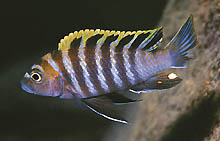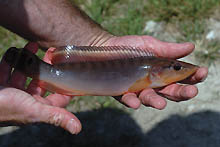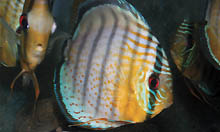WHAT'S NEW
ACROSS THE WORLD
Select date in side bar to go to a What's New of previous issues
| What's New
©by Laif DeMason
Another winter is behind us and summer is here. With the extra leisure time that summer usually brings, why not budget a little time to give some young people in your community a gift—an introduction to a great hobby: fish keeping! Organize with the manager of a large fish store in your area to bring a small group of youngsters to the store. Often the store already gives tours to small groups; a good business idea. Don’t have a good fish store nearby? Organize a group trip to the local public aquarium. Present your ideas to your kids’ summer camp counselor or their scout leader or their youth group. Ask them if you can give a short “how to” lesson before the tour. Let’s get our kids off the “shoot-em-up” video games they spend hours with, even if it is only your kid helping to change water or feed the fish at home; a constructive alternative. The future is in our hands!
Here’s “what’s new” on the cichlid scene:
|
Lake Tanganyika
The usual exporters around Lake Tanganyika are hitting on all cylinders! Business is up for most of them and they are happy to comply. Helped by the still keen interest in Tropheus and Petrochromis, as well as most goby cichlids, exports are brisk. A very few species’ prices have spiked due to short supplies and good demand from hobbyists in Far East countries like China.
|
what's
new: Lake Tanganyika
|

Collected from south of Kipili, in Mkinga, Tanzania, Telmatochromis vittatus is an odd-ball lamprologine not often seen available from importers. Unusual cichlids like this are attractive to many Tanganyika collectors if only for the new breeding challenge.
|

Several Tropheus varieties, especially the lesser known ones from Zambia, are in demand by those hobbyists who yearn for something a bit off the standard mark. Here T. moorii ‘Chilanga red’ reportedly from the Nkamba area, often assumes a darker red coloration.
|

From Moliro, Congo, Cyprichromis sp. ‘leptosoma jumbo’ has been available again. This fish is a jumbo type of leptosoma sporting a markedly yellow throat area as well as different colored dorsal fins and tails that are typical for these types. Photo by A. Konings.
|

Several populations of dark blue varieties of Cyphotilapia frontosa exist in southern Congo. Many American hobbyists proclaim that the Moba location has the deepest blue fish. However the Mikula frontosa pictured here is now favored by some.
|
Lake Malawi
The main exporter(s) on Lake Malawi are working hard to get their ‘mojo’ back. By choosing nearby and less often collected locations, this has given rise to a better selection and thus interest from hobbyists. A larger species list with fewer individuals of each species has given resellers better economics to sell these increasingly expensive fishes. Several newer forms have also popped up to help sway hobbyists to buy.

Tropheops sp. ‘elongatus Mazinzi’ is new variety but an odd looking fish with good color. Look at the typical underslung narrow mouth of a Tropheops and the elongated body of an elongatus, odd indeed! Photo by T. Judy
|

An unusual item not often collected, Copadichromis chrysonotus was reportedly captured from Namalenji Island. Generally, Malawians occupy and fish for food on several nearby islands, air-drying their catches to sell.
|

A cichlid that is almost certainly never seen for sale is Pseudotropheus galanos from Mbenji Island—until now. The shape of the body and mouth indicates it is likely closely related to the type specimen of the genus, Ps. williamsi.
|

There are several new varieties/locations where Cynotilapia afra are caught and exported. Recently an afra called Ntekete has been exported. This fish sports both red and white markings in the dorsal fin. Photo by A. Konings.
|
Neotropics
What can I say about Neotropical cichlids? Collecting season in South America is coming to a close. However last quarter, supplies were plentiful. Many of the wild cichlid species are caught when catching other fishes seasonally. This year we have seen a lot of odd species as well as unusual pikes and dwarf species. Many wild discus were also offered but recent prices for these fish have gone through the roof!

Exported from Colombia and reportedly from the Orinoco River, Crenicichla sp. ‘atabapo II’ or ‘fire pike’ were available earlier this year. Rather large and expensive for an import, these were snapped up quickly.
|

Symphysodon aequifasciatus or green discus was recently shipped from Colombia. Many wild discus are quite expensive compared to five years ago, more than double in price. Maybe exporters are following price trends for the new designer strains from discus breeders.
|
Select date in side bar to go a What's New of previous issues
|









